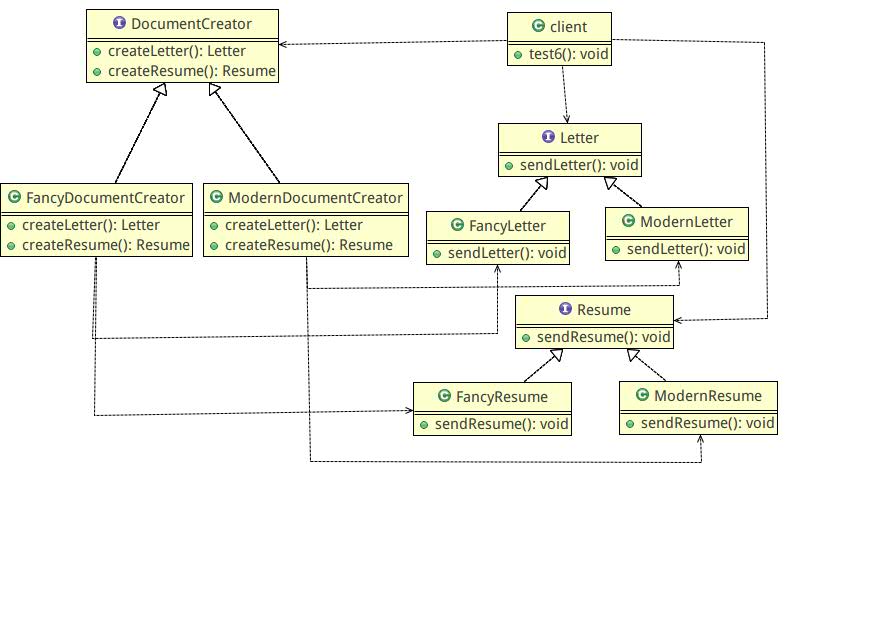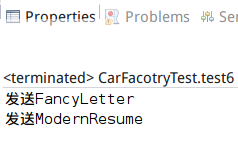抽象工厂设计模式
概念
抽象工厂模式(英语:Abstract factory pattern)是一种软件开发设计模式。抽象工厂模式提供了一种方式,可以将一组具有同一主题的单独的工厂封装起来。
在正常使用中,客户端程序需要创建抽象工厂的具体实现,然后使用抽象工厂作为接口来创建这一主题的具体对象。客户端程序不需要知道(或关心)它从这些内部的工厂方法中获得对象的具体类型,因为客户端程序仅使用这些对象的通用接口。
抽象工厂模式将一组对象的实现细节与他们的一般使用分离开来。
适用性
在以下情况可以考虑使用抽象工厂模式:
-
一个系统要独立于它的产品的创建、组合和表示时。
-
一个系统要由多个产品系列中的一个来配置时。
-
需要强调一系列相关的产品对象的设计以便进行联合使用时。
-
提供一个产品类库,而只想显示它们的接口而不是实现时。
UML

例子
一个抽象工厂类叫做DocumentCreator(文档创建器),此类提供创建若干种产品的接口,包括createLetter()(创建信件)和createResume()(创建简历)。
public interface DocumentCreator {Letter createLetter();Resume createResume();}
其中,createLetter()返回一个Letter(信件),createResume()返回一个Resume(简历)。
系统中还有一些DocumentCreator的具体实现类,包括FancyDocumentCreator和ModernDocumentCreator。
public class FancyDocumentCreator implements DocumentCreator {public Letter createLetter() {return new FancyLetter();}public Resume createResume() {return new FancyResume();}}
public class ModernDocumentCreator implements DocumentCreator {public Letter createLetter() {return new ModernLetter();}public Resume createResume() {return new ModernResume();}}
这两个类对DocumentCreator的两个方法分别有不同的实现,用来创建不同的“信件”和“简历”(用FancyDocumentCreator的实例可以创建FancyLetter和FancyResume,
public class FancyLetter implements Letter {public void sendLetter() {System.out.println("发送FancyLetter");}}
public class FancyResume implements Resume {public void sendResume() {System.out.println("发送FancyResume");}}
用ModernDocumentCreator的实例可以创建ModernLetter和ModernResume)。
public class ModernLetter implements Letter {public void sendLetter() {System.out.println("发送ModernLetter");}}
public class ModernResume implements Resume {public void sendResume() {System.out.println("发送ModernResume");}}
这些具体的“信件”和“简历”类均继承自抽象类,即Letter和Resume类。
public interface Letter {public void sendLetter();}
public interface Resume {public void sendResume();}
客户端需要创建“信件”或“简历”时,先要得到一个合适的DocumentCreator实例,然后调用它的方法。一个工厂中创建的每个对象都是同一个主题的(“fancy”或者“modern”)。客户端程序只需要知道得到的对象是“信件”或者“简历”,而不需要知道具体的主题,因此客户端程序从抽象工厂DocumentCreator中得到了Letter或Resume类的引用,而不是具体类的对象引用。
public void test6() throws Exception {// 客户端需要华丽的LetterDocumentCreator dc1 = new FancyDocumentCreator();Letter letter = dc1.createLetter();letter.sendLetter();// 客户端需要现代化的ResumeDocumentCreator dc2 = new ModernDocumentCreator();Resume resume = dc2.createResume();resume.sendResume();}
结果:
“工厂”是创建产品(对象)的地方,其目的是将产品的创建与产品的使用分离。
抽象工厂模式的目的,是将若干抽象产品的接口与不同主题产品的具体实现分离开。
这样就能在增加新的具体工厂的时候,不用修改引用抽象工厂的客户端代码。
使用抽象工厂模式,能够在具体工厂变化的时候,不用修改使用工厂的客户端代码,甚至是在运行时。然而,使用这种模式或者相似的设计模式,可能给编写代码带来不必要的复杂性和额外的工作。正确使用设计模式能够抵消这样的“额外工作”。























 1207
1207

 被折叠的 条评论
为什么被折叠?
被折叠的 条评论
为什么被折叠?








